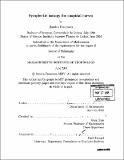Symplectic isotopy for cuspidal curves
Author(s)
Francisco, Sandra
DownloadFull printable version (1.996Mb)
Other Contributors
Massachusetts Institute of Technology. Dept. of Mathematics.
Advisor
Gang Tian.
Terms of use
Metadata
Show full item recordAbstract
This work has three purposes. The first one is to prove unobstructedness of deformation of pseudoholomorphic curves with cusps and tacnodes. We show that if the first Chern class of a 4-dimensional symplectic manifold is sufficiently positive then the deformation is unobstructed. We prove this result when the curves have cusps and nodes, not in a prescribed position. We also prove a similar result when the curves have cusps and tacnodes in a prescribed position with a prescribed tangency and in addition nodes, not in a prescribed position. The second part of this work deals with the local symplectic isotopy problem for cuspidal curves. Let B be the unit ball in R4 with the standard symplectic form wst. Let J0 be a wst-tame almost complex structure. Let Co c B be a connected J-holomorphic curve in B with a isolated singularity at 0 E B and without multiple components. Assume in addition that the boundary OCo is smoothly embedded. We prove that any two connected, reduced pseudoholomorphic curves in B, with the same number of irreducible components, the same number of nodal points and at most one ordinary cusp point, both sufficiently close to Co, are symplectic isotopic to each other. The third part of this work deals with the global symplectic isotopy problem. As an application of unobstructedness of deformation, we show that any irreducible rational pseudo-holomorphic curve in CP2 of degree d, with only nodes and m ordinary cusps as its singularities, is symplectic isotopic to a holomorphic curve as long as d > m.
Description
Thesis (Ph. D.)--Massachusetts Institute of Technology, Dept. of Mathematics, 2005. Includes bibliographical references (p. 53-55).
Date issued
2005Department
Massachusetts Institute of Technology. Department of MathematicsPublisher
Massachusetts Institute of Technology
Keywords
Mathematics.